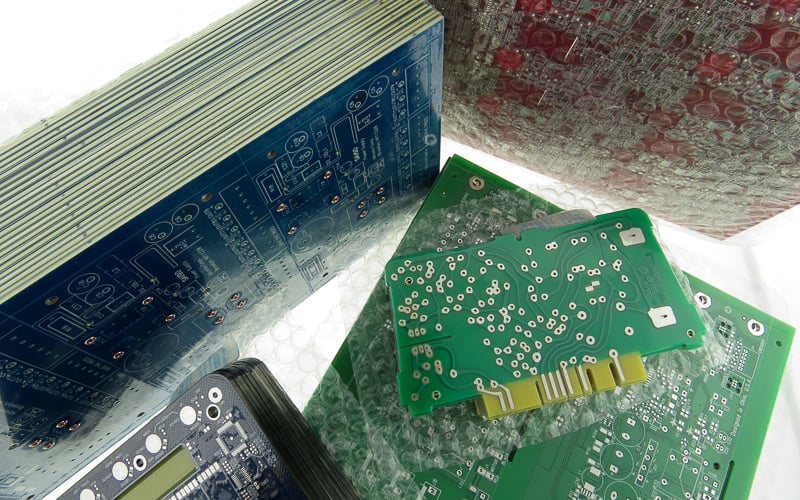Printed circuit boards (PCBs) may go through extreme wear-and-tear based on environmental factors. They may be placed in applications where there will be fluctuating temperatures, extreme heat, extreme cold, high humidity, salt water, and excessive moisture.
Customers need to ensure that their circuit boards can withstand differing environments effectively without causing an impact to the performance or reliability of the PCB. Determining the shelf life of a PCB during the build phase is essential so that customers will know how long or short the board will last when used in certain environments and when the board is placed into storage. The shelf life of the PCB is reliant on the specs that are used for the build and the surface finishes. Knowing these factors will allow the customer to select the PCBs that will provide exceptional shelf life.

Various printed circuit boards packaged in bubble wrap.
Specifications of the Printed Circuit Board
Every customer will have differing specifications based on what the circuit board must accomplish in the application, the size of the circuit board, and its complexity. The industry in which the circuit board is used will also have an impact on how it is manufactured. Certain industries, such as medical, will have established regulations on the types of materials and components that are allowed to be used in the PCB.
The functions of the application will determine the type of PCB that will be needed. There are numerous types of PCBs that can be built: single layer PCBs, double layer PCBs, multi-layer PCBs, flexible PCBs, rigid-flex PCBs, high frequency PCBs and aluminum-backed PCBs. Simple application functions may only require single-layer circuit board, while applications with movable components with limited space may require a more flexible or rigid-flex design for the PCBs.
Also, the type of PCB that is chosen will dictate the amount of materials and components which will be used, as this aspect factors into the PCBs shelf life. Highly complex and multi-layered PCBs will require additional components including resistors, capacitors, and diodes as these components' leads and base boards will be connected using solder joints. The materials used for these components will have an established life cycle.
Solders
The solder, adhesives, and chemicals used will also determine the board's life cycle. When the circuitry is in use in the application, it will experience oxidation. This oxidation will impact the solder, solder joints, and adhesives on the PCB. In time, failures can appear that will cause connectivity issues and poor performance.
The environment where the PCB will be used can also create higher levels of oxidation over time. Customers must evaluate these conditions, along with how the PCB will be in operation, to determine possible shelf life. Depending on the solder that is used and the specific soldering method, the PCB could potentially last up to 10 years.
PCB Plating
During the fabrication and pre-assembly phases, the PCB will undergo a plating process. This plating option provides an extra layer of protection to the base board and can increase the shelf life of the PCB.
Finishes Used for Plating Include:
- Sn/Pb Hot Air Solder Level (HASL): HASL is comprised of solder with about 63% tin and 37% lead. The PCB is dipped into the molten alloy after solder mask is applied as hot air knives remove the excess, so a thin layer of finish is on the board.
- Lead-Free HASL: This finish replaces the lead with 0.6% copper and increases the tin ratio to 99.3%. It is applied in the same way as HASL.
- Organic Solderability Preservative (OSP): A water-based finish that is lead free and environmentally friendly. It contains organic compounds of rosin, azole, and active resin.
- Immersion Silver: A layer of silver becomes plated to the PCB as electroless immersion is used so the silver will bond to the copper traces. It is commonly used for high-speed PCB applications.
- Immersion (White) Tin: Similar to immersion silver, immersion tin finishes have a thin layer of tin on the PCB's copper layer. An electroless chemical bath is used to apply the plating.
- Electrolytic Nickel/Gold (Hard Soft Au Wire Bondable): This finish uses a layer of nickel electroplated onto the PCB as a layer of gold is placed on top of the nickel. Hard gold at a ratio of 99.6% purity or soft gold of 99.9% purity is used.
- Electroless Nickle Immersion Gold (EIGN): This plating process involves using a double layer metallic finish. An electroless procedure plates the nickel onto the copper pads. Then an immersion process is used to place a gold layer on top of the nickel to ensure that the exposed traces and pads are covered.
- Electroless Nickel Electroless Palladium Immersion Gold (ENEPIG): This finish has four layers of alloy materials that is layered on top of each other. These materials are copper, nickel, palladium, and gold. The first layer is copper along the substrate and then the nickel is added. Palladium is placed on top of the nickel to prevent corrosion. Lastly, gold is placed on top as the last layer to ensure the board is completely protected.
Each listed surface finish will have a specific shelf life based on the storage of the board, the PCB vendor who applies the plating, and the grade of the materials. For example, OSP surface finishes are based on the vendor and grade as the PCB board Entek Cu-56 typically has a shelf life range of 3-6 months while the Entek Plus-HT has a shelf life of 6-12 months. Tin/Lead Hot Air solder leveling finishes will typically have a shelf life range from 6 months to a year based on IPC-1601 guidelines, while ENIG finishes will have a solderability shelf life of up to 6 months.
Typical Solderability Shelf Life for Surface Finishes:
- Sn/Pb Hot Air Solder Level (HASL): 12 months
- Lead-Free HASL: 12 months
- Organic Solderability Preservative (OSP): 6 months
- Immersion Silver: 6 months
- Immersion (White) Tin: 6 months
- Electrolytic Nickel/Gold: 6-12 months
- Electroless Nickle Immersion Gold (ENIG): 12+ months
- Electroless Nickle Electroless Palladium Immersion Gold (ENEPIG): 12+ months
See our technical article on Printed Circuit Board Surface Finishes: Advantages and Disadvantages for more information on PCB surface finishes.
Conformal Coating
A conformal coating is placed onto the board as another form of protection against corrosion. It is a thin layer of polymer that can be applied to exposed traces, component leads, and solder joints.
Some industries require that conformal coatings be applied to the PCBs, such as marine, aerospace, military, automotive, and industrial applications. Different types of conformal coatings may be used. Types of coatings may involve acrylic, silicone, polyurethane, water-based, and hybrid materials.
Circuit Board Handling and Shipping Factors
Even if every precaution is taken during the design, pre-assembly and fabrication processes, the PCBs shelf life may still be impacted during the handling and shipping phases. PCB fabricators must ensure that circuit boards are handled and cleaned properly before being stored or shipped. Contaminations from the working environment or worker's hands may be placed onto the PCB. When sweat, chemicals, or dirt is introduced, these contaminants can wear out the protective layers and corrode the components.
Customers should also be aware of how shipping the PCBs will shorten the shelf life of the components. Moisture can penetrate the inner layers of the PCB board if they are left in moisture-prone shipping environments. Temperature-controlled vehicles can prevent the circuit boards from being delivered in a defective state. Once arriving at the destination, the PCB should be stored in a dry and warm room that has low humidity and a consistent temperature.

Example of printed circuit boards packaged with humidity indicator.
Date Codes on PCBs
Simply looking at a circuit board and examining its materials, solder, and other components will not help customers know how long the shelf life will be. Instead, fabricators of PCBs will mark the board with a four-digit date code. This code will inform customers about the shelf life of the PCB.
A typical date code for a PCB (not including military PCBs), have a week/year format. The first two digits will have the week number. The last two digits will be the last digits of the year. So, if the date code is 5224, it would mean that the last week of December 2024 would be the shelf life of the PCBs. For military printed circuit boards, the date code is reversed with a year/week format.
Summary
Since there are so many factors involved with the circuit boards shelf life, getting a qualified fabricator and providing thorough specs will allow customers to fully understand how long their PCBs will last for specific applications. Then, with help from the fabricator, the customer can decide on the right materials, surface finishes, conformal coatings, and other aspects that will work best for the PCB build.
Key Takeaways
- Shelf life is heavily influenced by the environment: Exposure to heat, humidity, salt water, or extreme temperatures can degrade PCB performance over time, making environmental considerations essential during the design and storage phases.
- Solder and surface finish play a critical role: The type of solder and surface finish (such as HASL, ENIG, or OSP) directly impacts oxidation resistance, solderability, and shelf life, ranging anywhere from 3 to 12+ months.
- Plating and coatings extend durability: Surface plating (like ENEPIG or immersion silver) and conformal coatings add extra protection against corrosion, especially in high-stress industries like automotive, aerospace, and marine.
- Proper handling and shipping are non-negotiable: Contaminants like moisture, oils, or dirt introduced during handling or shipping can reduce shelf life, making cleanroom procedures and climate-controlled logistics critical to PCB integrity.
- Date codes are essential for traceability: PCBs are marked with standardized date codes (week/year or year/week) to help manufacturers and customers track the board's age and assess remaining shelf life, especially during storage or before assembly.
















